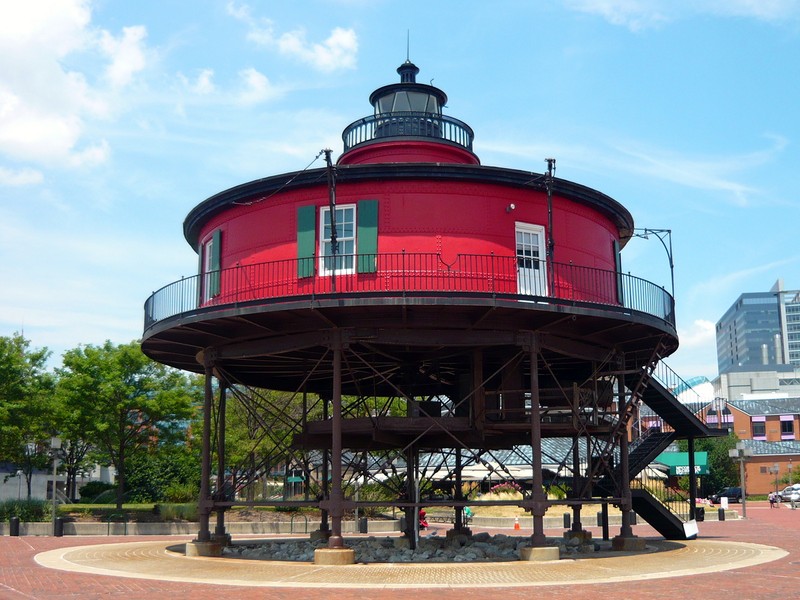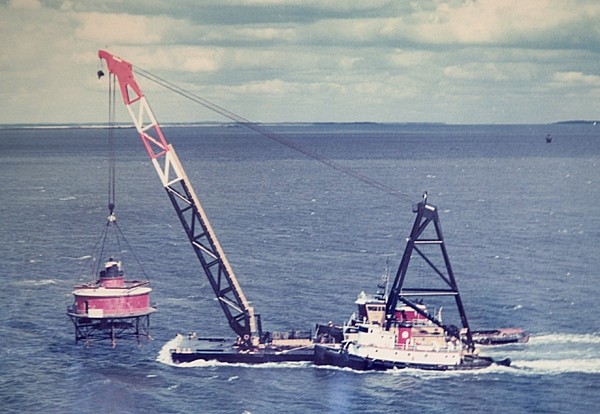Seven Foot Knoll Light
Introduction
Text-to-speech Audio
Originally built in 1856, the Seven Foot Knoll Light was the first "screw-pile" lighthouse erected in Maryland and is one of only four of its kind remaining in Chesapeake Bay. The cast-iron structure featured a fourth order Fresnel lens and was located on a shoal at the mouth of the Patapsco River. It is now on Pier 5 in the inner harbor and a part of an outdoor museum called the Historic Ships in Baltimore, which includes four historic vessels. The light is open to the public and features artifacts on display such as the bell from the SS Danville and navigational instruments. The light was added to the National Register of Historic Places in 1989.
Images
The Seven Foot Knoll Light was built in 1856 and originally stood in the mouth of the Patapsco River. It was the first "screw-pile" lighthouse built in Maryland and is now a part of Historic Ships in Baltimore.

The light as seen on its original location.
.jpg)
This map shows where the light was located (the center of the image) in mouth of the Patapsco River.
.jpg)
The light was transported to its present location in 1988.

Backstory and Context
Text-to-speech Audio
The screw-pile light originated in Britain and it had a number of advantages over other types of lighthouse construction methods. Instead of using underwater caissons and heavy masonry foundations, screw-pile lights were built using hollow cast-iron piles with external threads. The piles were screwed into the bedrock and then filled with concrete, and the supports of the house were then built on top of the piles.
The first screw-pile light in the United States was the Brandywine Shoal light in Delaware Bay, which was erected in 1850. Its success prompted the Lighthouse Board to select the screw-pile method for the Seven Foot Knoll Light, which was meant to replace the 1822 Bodkin Island Lighthouse located on the south side of the Patapsco River's mouth. Congress appropriated funds for the project in 1850 and the design and specifications were completed in October the next year. By then, Congress had approved $27,000 for the new light.
A local company called Murray and Hazelhurst was hired to manufacture the ironwork, which was entirely prefabricated. This accelerated and simplified construction. Cast-iron was an ideal choice for another reason. At the time, the city was emerging as an important cast-iron manufacturing center with many companies that specialized in iron castings and machine building. When completed, the lighthouse featured nine screw piles and a 40-foot diameter, circular dwelling with a one-inch thick wall consisting of panels bolted together. The lens was housed in a circular lantern room on the roof. The lantern emitted a white light that could be seen 14 miles away. The lighthouse also had a 500-pound fog bell. The dwelling was replaced around 1875.
Ice flows were a constant threat. In January 1884, they severely damaged one of the piles, rendering the lighthouse unsafe and the keepers were rescued by a lighthouse tender vessel. One-hundred fifty Wooden piles grouped in bunches of ten were driven into the sea floor surrounding the lighthouse as a temporary measure to protect it. However by 1894, they all but disappeared and ice flows damaged the piles once again. As a result, 790 cubic yards of riprap (rocks specifically placed for protection) were laid around the piles.
Numerous lighthouse keepers and assistants manned the lighthouse. Many families lived here as well. A daughter of one keeper, Eva Marie Bowling, lived at the light with her family from 1874-1879. In an interview with a local newspaper, she said that the lighthouse had five large rooms and animal pen for hogs and chickens on a platform underneath the dwelling. Sometimes they would be swept away but the family rescued them. The family also caught fish and traded some of them with farmers for vegetables. Eva's mother was a teacher and homeschooled her and her siblings.
One keeper, Thomas Jeffesron Steinhise, earned praise for his actions on August 20, 1933. On that day a tugboat called Point Breeze got caught in a violent storm and began to sink. Steinhise heard distress whistles and got in a small motorboat and sailed to the tugboat, braving 15-foot waves and 90 mph winds. He pulled six crew members, including one who had died, onto his boat. Fortunately another tugboat rescued the remaining eight crew members. Steinhise was awarded the Silver Lifesaving Medal and Congressional Medal of Heroism for his actions.
Seven Knoll Light was automated in 1948. Without a keeper to maintain it, it began to fall into disrepair and vandals caused further deterioration. The Coast Guard designated it excess property in 1969. Finally, the city acquired it in 1987 and the next year was moved to its current location on Pier 5. By then it was in very bad shape and would have eventually collapsed into the water. Restoration took around a year before it opened to visitors. In 1997, it became part of the Baltimore Maritime Museum, which is now Historic Ships in Baltimore.
Sources
"Seven Knoll Lighthouse History." Historic Ships in Baltimore. Accessed February 1, 2023. https://historicships.org/explore/sevenfootknoll-lighthouse.
"Seven Knoll Lighthouse." Lighthouse Friends. Accessed February 1, 2023. https://www.lighthousefriends.com/light.asp?ID=419.
"Seven Knoll Lighthouse." U.S. Coast Guard Historian's Office - Historic Light Information: Maryland. 2018. https://media.defense.gov/2018/Jul/09/2001940171/-1/-1/0/LHMD.PDF
"Seven Knoll Lighthouse." United States Lighthouse Society - Chesapeake Chapter. Accessed February 1, 2023. http://www.cheslights.org/heritage/seven-foot.htm.
Zembala, Dennis. "Seven Knoll Light." National Park Service - National Register of Historic Places Nomination Form. August 22, 1989. https://mht.maryland.gov/secure/medusa/PDF/NR_PDFs/NR-1040.pdf.
Wikimedia Commons
Lighthouse Friends
